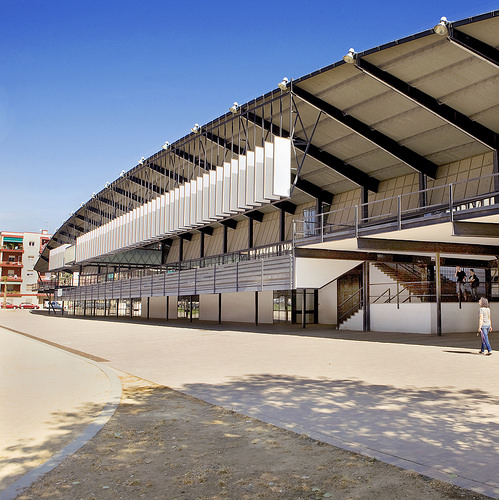
Among the San Andreu and Sagrera districts, near the Meridiana Avenue, is the former Meridiana dog track (which is called Canódromo Meridiana), an emblematic rationalist building of the sixties, designed by the architect Antonio Bonet Castellana, one of the most influential architects in the rationalist architecture of our country.
Under the priority of promoting creativity and innovation in the city, Barcelona will convert the unique building of Barcelona into a new Creative Research Park.
With a clear bet for the creative talent existing in the city and the development of cultural industries, the idea is to create in the former dog track of the capital of design a place for creative companies and creators.
This initiative will facilitate the production of new creative proposals and its market launch, and will help strengthen cultural activity in the city.
The project will begin carrying out the next month of September and will entail a cost of 1.5 million euros.
According to the explanation of the Mayor of Barcelona, Xavier Trias, it “reflects a new economic model of the city, picked European capital of innovation.”
The rehabilitation is responsibility of the architects Xavier Monteys and Josep Maria de Lecea, who have respected and conserved the original building left border to a big public garden whose design allows guess the circuit where the dogs ran after the hare.
The building shape is characterized by its floor plan formed by the union of a straight line and parabolic line, and structural own language with an expression of absolute lightness, through a repetition of eighteen inclined metal porches on which rests the cover, a thin sheet-shaped parabolic.
The brutalist building character shows its construction understood as an instrument to demonstrate the relationship between materiality and spatiality.
The building was precursor and bold in his time, in the same way as was its architect when projecting. Antonio Bonet, back from exile in Uruguay, won the bet to create a vibrant space activity through the use of a language of a radical contemporary.
The adrenaline of the game, the need to relation and the spaces of a first level architecture, created an atmosphere that characterized it and made it a special place.
The dog track in the neighborhood was the meeting place where people gossiped and shared, laughed and argued, watched and learned, negotiated and competed, survived and died… An attractive place full of contrasts which now reborns as a meeting place for artists and creative businesses.
It remains to be seen whether the reinvention of this masterpiece as Research and Innovation Park will be able to revive the area and getting set up an own economic dynamic that not only will benefit the neighborhood but it aims to reach international markets.
Johannes Wortmann with Eva Ybáñez and Marc Calvo.
Wortmann Architects
SOURCES:
Bibliography:
“Arquitectura de Barcelona” Josep Emili Hernàndez-Cros, Gabriel Mora y Xavier Pouplana.
“Cànodrom 00:00:00” Margarita Andreu, Xavier Arenós, Marc Arroyo, Isabel Banal, Ana de Matos, Albert Jusi, Gustavo, Jordi Mitjà, Observatori Nòmad
Webiography:
https://canodrom.wordpress.com
http://www.urbipedia.org/index.php?title=Can%C3%B3dromo_Meridiana
https://www.flickr.com/photos/89761283@N06/15703144790/in/set-72157649483441112
Video:
“Canòdrom/Canòdrom” A series of interviews of older workers and users of Meridiana’s Canódromo of Barcelona in occasion of the imminent transformation of the building in a center of contemporany art.
A project of Observatori Nòmada Barcelona direct by Pere Grimau, Domènec y Pau Faus.
“Canòdrom Parc de Recerca Creativa” of BCN innovació
Cut of the film “PETIT INDI” of Marc Recha (2009)
Scenes filmed in the Meriana’s Canódromo of Barcelona
